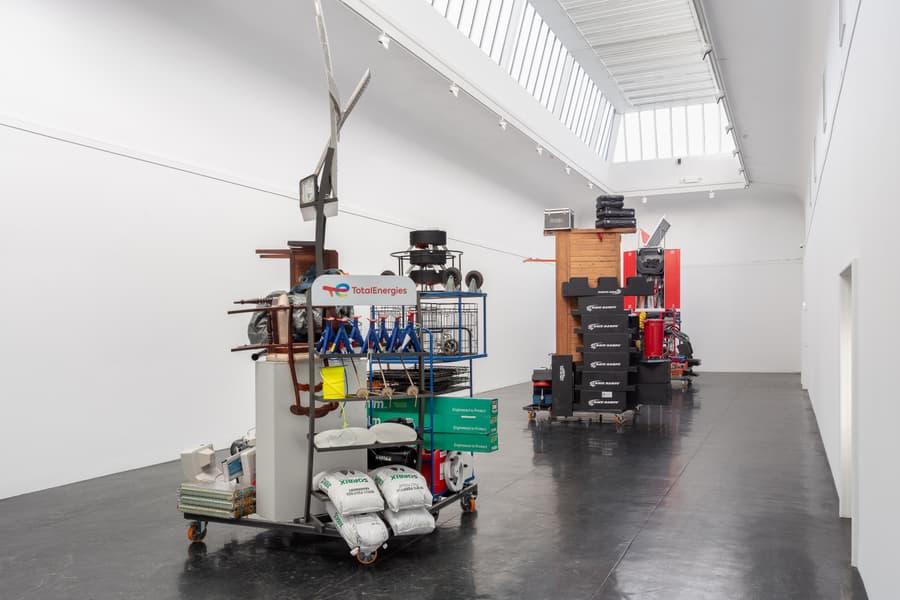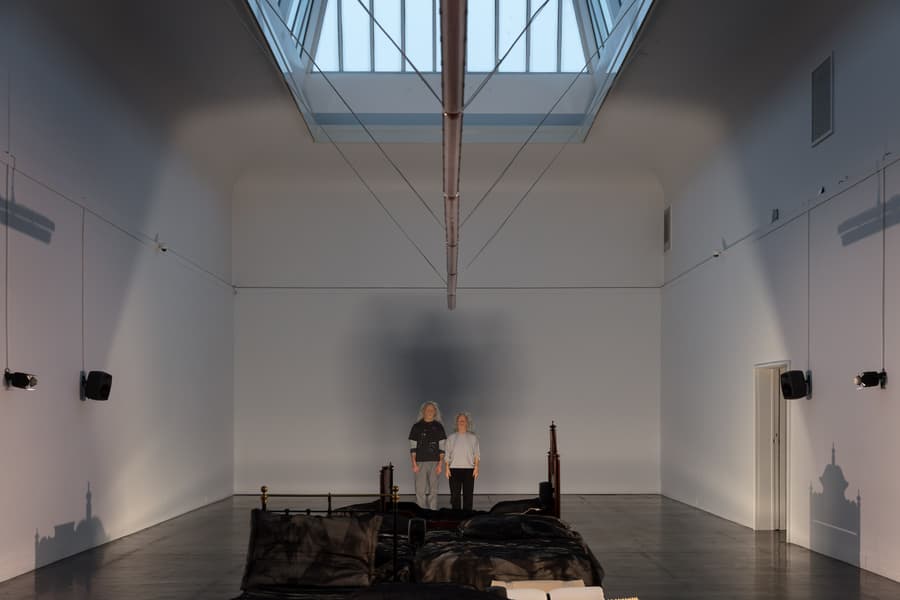Arkitekten Auguste Perret

In 1949, Kunstnernes Hus had an exhibition of drawings and photographs from projects by the revolutionary French architect Auguste Perret.
Catalog text
AUGUSTE PERRET
was born in Ixelles in 1874. In 1886 he was admitted to the Ecole des Beaux-Arts in Paris. After graduating, he established an architectural firm with his brother G. Perret and later a free school of architecture in opposition to Beaux-Arts. Perret's ideas prevailed and he himself became associated with the Ecole des Beaux-Arts, first as a member of the judging committee, later as inspector general of teaching. Perret is president of the Conseil supérieur de l'ordre des Architectes. In 1943 he was elected to the Institut de France and recently appointed commander of the Legion of Honor.
Auguste Perret
The new French art magazine Art Present published in its first issue (No. 1, 1947) three articles about Auguste Perret written by the architects José Imbert, Pierre Lambert and André le Donné. A summary of this French assessment of Perret's efforts and significance is presented here (reproduced from the catalog for the Danish exhibition).
Auguste Perret is one of France's greatest architects. His personality, his work, his teaching, and the admirable devotion shown to him by his students have created a luster of his name in France, which is difficult for a foreigner to fully comprehend.
But Perret's significance extends far beyond France's borders. His work is of such a format and has had such an influence on the development of modern architecture, that it is justified to mention the name Auguste Perret in the same breath as the greatest names in the history of architecture.
In order to understand Perret's efforts, it must be seen in a historical context. It marks an important section in the history of architecture: the transition from one era to another, from one construction technique to a new one and thus from the design language of the past to the present.
The art of construction is strongly linked to the technical advances; creating great architecture is not least a matter of perfectly mastering and mastering a technique. But it rarely happens that a single architect manages with one stroke to introduce a new technique and at the same time to formulate its aesthetics. As a rule, the individual builder is only a part of an uninterrupted series of teachers and students, and each individual's personal effort is limited to a more or less clear expression of his temperament associated with a particular technique. The ever-advancing enrichment, the transition from one approach to another, naturally occurs through the direct intervention of particularly gifted and creative men, but every decisive step is, so to speak, through infinitely long time prepared and matured. With Perret's efforts, however, a new technique and thus a new architecture was created with one stroke.
At the turn of the century, at a time when only a few understood the possibilities of reinforced concrete and no one understood how to take advantage of them, Perret saw clearly that a new architecture lay hidden in this material. As an ingenious builder, from his youth brought up to exact knowledge of the materials and with considerable personal experience, it was natural for Perret to analyze the special properties of the new material. And with his rare artistic sensitivity that allowed him to absorb nourishment from architecture's most distant but reliable sources, it was an equally natural matter for him to create great architecture with this material.
In his work, Perret treated the new substance in accordance with the laws that on the one hand are determined by the inner properties of the material, on the other hand rely on certain purely human reactions, such as a sense of rhythm, harmony and plasticity.
The unique strength of reinforced concrete allows a fantastic reduction of the load-bearing surface compared to the enormous amounts of load-bearing masonry in stone or brick buildings. Perret utilizes this strength by distributing the building's weight on a system of vertical load-bearing joints, columns or posts, interconnected by horizontal beams that support the storey dividers.
As the first, Perret thus created the new constructive system: the reinforced concrete skeleton, a system that satisfies the instinctive human demand for a visible balance and stability. Through the diversity of the vertical bearing joints, he introduces the number as a factor; the interaction between many and few joints or the repetition of the joints creates rhythm, and the relationship between the height and the width of the fields formed between the vertical and horizontal bearing joints, creates proportions. Other elements that have a function to fulfill, e.g. the errors. which fills the skeleton and forms the outer walls, frames that enclose the openings and cornices that form protection, completes Perret's system, a system that allows us to perceive the entire construction of the building through factors that particularly speak to our sense of the plastic.
The remarkable thing about Perret's efforts is that he not only was able to analyze the constructive possibilities of reinforced concrete, but that he as an artist could also realize these possibilities and create works that are known and admired worldwide for the beauty and clarity of the plan, the careful preparation of the constructive elements and for the logic and boldness of the conception of form. These works, which testify to the luminous clarity of his mind and his classical formation, have exerted a strong influence on the art of construction worldwide.
But Perret has not only indirectly in his works influenced several generations of architects, he is also the great teacher in the style of the famous artists of the Renaissance. Already his first works attracted young architects so that they, like apprentices in the old days, came to him to work in his and his brother's drawing room. Among them was le Corbusier. As the boredom of the official academic teaching at the Ecole des Beaux Arts grew, so did the crowd around Perret, and at the Palais de Bois de la Porte de Maillot, these daring young people established a kind of free school of architecture under Perret's inspiring leadership.
For 2 years they fought bravely for the new ideas and sent project after project for assessment at the Ecole des Beaux Arts - where they were consistently rejected. The clear constructive and proven sober design of these projects was in fact in the sharpest contradiction to the academic and failed traditional routine that was taught at the Ecole des Beaux-Arts. Perret himself was not a member of the judging committee at the time and therefore could not support the new ideas.
In the face of this compact opposition, the idealists of the Palais de Bois had to give up, and the school was dissolved. But their efforts had not been in vain. Independent artistic and intellectual circles, supported by the press, objected to the blatant injustice of such a ban. The director of the l'Ecole spéciale d'Architecture in Paris offered Perret to lead one of the school's classes, and here, as in the brothers Perret's own drawing room, talented students from both France and abroad gathered, students whose personality would soon unfold and who thereby fortified Perret's reputation as the great teacher. Countless architects who had not been directly taught by Perret, but who recognized the universality of his thoughts, simultaneously built in France and abroad structures in the spirit of the master, and then the authorities had to bow. Perret was elected as a member of the Ecole des Beaux-Arts' judging committee, and later as the school's inspector general and immediately before the war he was admitted among the immortals of the Institut de France.
After the war, a group of students gathered around Perret to form a "studio" for reconstruction under his leadership. This "studio" is neither a school nor an architect's office, but almost a kind of working group led by one of Perret's old students from the Palais de Bois, André le Donné, and has been given the important task of rebuilding the war-torn le Havre - a rather fantastic task. Near the port are 150 hectares of the city as an extremely desolate stretch, and the oldest districts, Saint-Francois, Notre-Dame and Francois 1er, which formed the city's original core and had 56,000 inhabitants, has completely disappeared. So, as in most partially damaged French cities, it is not about repairs, not even about reconstruction, but simply about the construction of a completely new city, a city where planning is not bound by the old city plan that has emerged over the centuries, but is only subject to the laws of nature. Since the breakthrough of modern architecture, architects have only been able to realize their ideas in some isolated buildings or in certain blocks. For the first time, it will now be possible to create an entire urban community, so to speak, on a bare bottom, a city in which thousands of lives will unfold from birth to death. It is when one considers the social character of architecture, a task of immense reach - and one must with the greatest interest see it be solved in the radiance of Perret's genius.


